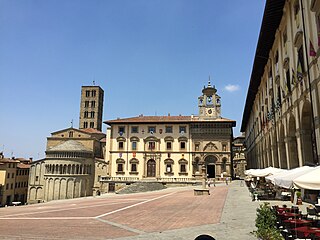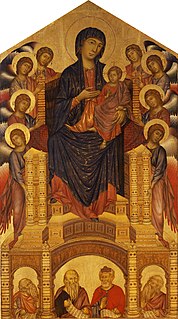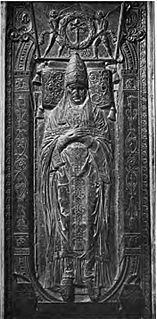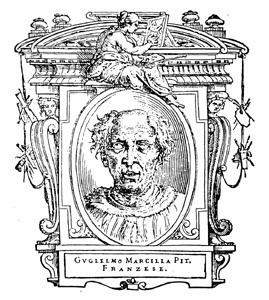
Lazzaro Vasari (1399–1468), also known as Lazzaro Taldi and as Lazzaro di Niccolò de' Taldi, was an Italian painter who was born in the Province of Arezzo. His father was a potter, as was Lazzaro Vasari’s son, Giorgio Vasari I. The painter Luca Signorelli (1441–1523) was Lazzaro Vasari’s nephew, and the art historian Giorgio Vasari was his great-grandson.

The province of Arezzo is the easternmost province in the Tuscany region of central Italy. Its capital is the city of Arezzo. The province is bordered by the regions of Marche, Emilia-Romagna, Umbria, and the provinces Siena and Florence of Tuscany. It has an area of 3,233 square kilometres (1,248 sq mi), a total population of about 344,000 in 36 comuni

Luca Signorelli was an Italian Renaissance painter who was noted in particular for his ability as a draftsman and his use of foreshortening. His massive frescoes of the Last Judgment (1499–1503) in Orvieto Cathedral are considered his masterpiece.

Giorgio Vasari was an Italian painter, architect, writer, and historian, most famous today for his Lives of the Most Excellent Painters, Sculptors, and Architects, considered the ideological foundation of art-historical writing.
Lazzaro Vasari’s best-known work is the fresco of Saint Vincent Ferrer in the Basilica of San Domenico in Arezzo, Italy. He died in Arezzo in 1468 and was buried at the Chapel of San Giorgio in the same city.

Fresco is a technique of mural painting executed upon freshly laid, or wet lime plaster. Water is used as the vehicle for the dry-powder pigment to merge with the plaster, and with the setting of the plaster, the painting becomes an integral part of the wall. The word fresco is derived from the Italian adjective fresco meaning "fresh", and may thus be contrasted with fresco-secco or secco mural painting techniques, which are applied to dried plaster, to supplement painting in fresco. The fresco technique has been employed since antiquity and is closely associated with Italian Renaissance painting.

Vincent Ferrer, O.P. was a Valencian Dominican friar, who gained acclaim as a missionary and a logician. He is honored as a saint of the Roman Catholic Church and other churches of Catholic traditions, like the Iglesia Filipina Independiente.

Arezzo is a city and comune in Italy and the capital of the province of the same name located in Tuscany. Arezzo is about 80 kilometres southeast of Florence at an elevation of 296 metres (971 ft) above sea level. It is also 30 km west of Città di Castello. In 2013 the population was about 99,000.












